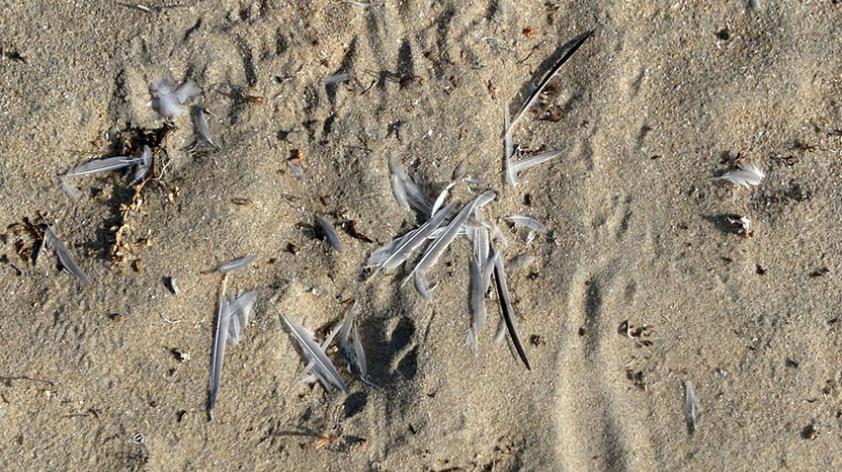
CSI: Coronado
Feathers from a California least tern mark the scene of the crime. (Photo by Maggie Lee Post, courtesy Naval Base Coronado)
I never expected to gain detective skills on the California least tern and western snowy plover project. As field biologists, our observation skills are critical in assessing nest success, chick survival, and other aspects of population ecology throughout the season. There are times when we walk up to a nest and something is amiss: the eggs are missing, an egg is punctured, or we might find just pieces of broken egg shell in the nest cup. This is when we get to an interesting aspect of our job: ‘crime scene’ investigation! Many predators try to take advantage of the hundreds of eggs in a tern colony and those in plover nests. We partner up with predator biologists to help solve these cases of nest predation and prevent more from happening.
Can you make out the American crow tracks? (Photo by Billy Smith, courtesy Naval Base Coronado)
Early in the season this year, when the first nests were being filled in the tern colony, the common raven and American crow (members of the Corvidae family) were the main threats. Clues left at the scene of the crime included tracks, pieces of egg shell, and sometimes even remnants of yolk in and around the nest cup. Once these clever birds figured out that we used small green sticks to mark each well-camouflaged nest, they found several other nests at one site. We quickly changed our marking tactics, and began using sea shells to mark nests. In the middle of the season, when the tern chicks were reaching that stage when they were just beginning to fly, we saw an increase in predation by raptors. Peregrine falcons and great horned owls were linked to some of the crimes. These skilled hunters make swift kills but leave messy crime scenes containing tracks, feather piles, and sometimes leftover pieces of their prey. Birds are not the only hunters in the area. Skunks and other small, opportunistic mammals use their keen senses to find and eat tern and plover eggs. Since most of these terrestrial creatures forage around dusk or at night, we are able to detect tracks and other signs during our morning patrol—and we definitely smelled a skunk’s presence at one of the beaches! Skunks are especially problematic because they are capable of digging under the exclosures we place over the plover nests to get to the eggs. Predator management is no easy task, and the predator biologists do an excellent and professional job. They come up with inventive scare tactics and other methods to alleviate the pressure on our protected birds. Our partnership gives the terns and plovers a chance to incubate their eggs and raise their chicks in peace. This is why I’m out here using my detective skills to help the terns and plovers nest successfully on the beaches of Coronado. Case closed. Melissa Murillo is a research associate at the San Diego Zoo Institute for Conservation Research.













